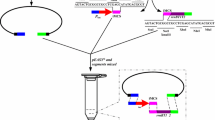Abstract
Here, we present the electroporation as a feasible and efficient method for introducing circularized and linearized DNA into Bacillus subtilis chromosome. Two integration experiments were carried out and demonstrated the feasibility and efficiency of electroporation to introduce the target DNA into the B. subtilis chromosome. By using of electroporation, a multiple-cistron contained five genes from B. subtilis biotin biosynthetic pathway was introduced into the B. subtilis chromosome efficiently and created a repeated copy in chromosome via a single crossover event. Then an ectopic promoter was introduced conveniently into the upstream of one of the repeated multiple-cistron via a double crossover event. To further demonstrate the application of electroporation in genetic research, the early sporulation gene spo0A of B. subtilis was knocked out and, consequently, the null of sporulation and logged growth was observed in this study. Thus, the electroporation as an alternative method of integration in B. subtilis is feasible and practical.




Similar content being viewed by others
References
Anagnostopoulos C, Spizizen J (1961) Requirements for transformation in Bacillus subtilis. J Bacteriol 81:741–746
Bower S, Perkins JB, Yocum RR, Howitt CL, Rahaim P, Pero J (1996) Cloning, sequencing, and characterization of the Bacillus subtilis biotin biosynthetic operon. J Bacteriol 178:4122–4130
Brans A, Filée P, Chevigné A, Claessens A, Joris B (2004) New integrative method to generate Bacillus subtilis recombinant strains free of selection markers. Appl Environ Microbiol 70:7241–7250
Bron S (1990) Plasmids. In: Harwood CR, Cutting SM (eds) Molecular biological methods for bacillus. Wiley, New York, pp 75–174
Chen I, Christie PJ, Dubnau D (2005) The ins and out of DNA transfer in bacteria. Science 310:1456–1460
Ferrari FA, Trach K, LeCoq D, Spence J, Ferrari E, Hoch JA (1985) Characterization of the spo0A locus and its deduced product. Proc Natl Acad Sci 82:2647–2651
Guerot-Fleury AM, Frandsen N, Stragier P (1996) Plasmids for ectopic integration in Bacillus subtilis. Gene 180:57–61
Kunst F, Ogasawara N, Moszer I, Albertini AM, Alloni G, Azevedo V, Bertero MG, Bessieres P, Bolotin A, Borchert S et al (1997) The complete genome sequence of the gram-positive bacterium Bacillus subtilis. Nature 390:249–256
Romero D, PéreZ-Garcia A, Veening JW, de Vicente A, Kuipers OP (2006) Transformation of undomesticated strains of Bacillus subtilis by protoplast electroporation. J Microbiol Methods 66:556–559
Sambrook J, Fritsch EF, Maniatis T (1989) Molecular cloning: a laboratory manual, 2nd edn. Cold Spring Harbor Laboratory Press, NewYork
Schaeffer P, Millet J, Aubert JP (1965) Catabolic repression of bacterial sporulation. Proc Natl Acad Sci 54:704–711
Schallmey M, Singh A, Ward OP (2004) Developments in the use of Bacillus species for industrial production. Can J Microbiol 50:1–17
Short JM, Fernandez JM, Sorge JA, Huse WD (1988) λ ZAP: a bacteriophage λ expression vector with in vivo excision properties. Nucleic Acids Res 16:7583–7600
Stamm LV, Folds JD, Bassford PJ (1982) Expression of Treponema pallidum antigens in Escherichia coli K12. Infect Immun 36:1238–1241
Xue GP, Johnson JS, Dalrymple BP (1999) High osmolarity improves the electro-transformation efficiency of the gram-positive bacteria Bacillus subtilis and Bacillus licheniformis. J Microbiol Methods 34:183–191
Yamamoto H, Serizawa M, Thompson J, Sekiguchi J (2001) Regulation of glv operon in Bacillus subtilis: YfiA(GLVR) is a positive regulator of the operon that is repressed through CcpA and cre. J Bacteriol 183:5110–5121
Yang MM, Zhang WW, Zhang XF, Cen PL (2006) Construction and characterization of a novel maltose inducible expression vector in Bacillus subtilis. Biotechnol Lett 28:1713–1718
Yuan G, Wong SL (1995) Regulation of groE expression in B. subtilis: the involvement of the sigmaA-like promoter and the roles of the inverted repeat sequence (CIRCE). J Bacteriol 177:5427–5433
Zhang AL, Liu H, Yang MM, Gong YS, Chen H (2007) Assay and characterization of a strong promoter element from B. subtilis. Biochem Biophys Res Commun 354:90–95
Zhang XZ, Yan X, Cui ZL, Qing H, Li SP (2006) MazF, a novel counter-selectable marker for unmarked chromosomal manipulation in Bacillus subtilis. Nucleic Acids Res 34:e71
Acknowledgments
Thanks BGSC for generously offering study materials. The financial supplement of national New Productions Project from science and technology ministry (People’s Republic of China) is gratefully acknowledged.
Author information
Authors and Affiliations
Corresponding authors
Additional information
Ming-Ming Yang and Wei-Wei Zhang have contributed equally to this work.
Rights and permissions
About this article
Cite this article
Yang, MM., Zhang, WW., Bai, XT. et al. Electroporation is a feasible method to introduce circularized or linearized DNA into B. subtilis chromosome. Mol Biol Rep 37, 2207–2213 (2010). https://doi.org/10.1007/s11033-009-9704-2
Received:
Accepted:
Published:
Issue Date:
DOI: https://doi.org/10.1007/s11033-009-9704-2




